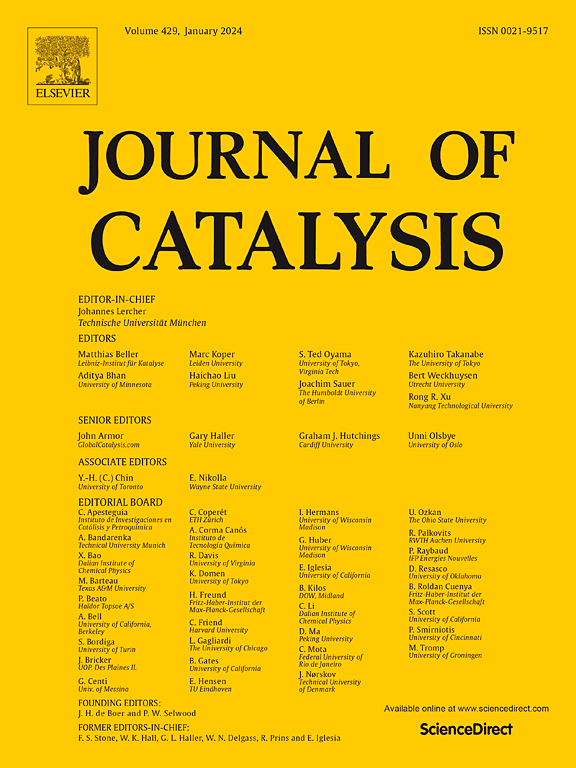负载Ru对LaMnOx催化剂中氧空位和路易斯酸位点的协同调节,促进乙酰丙酸和乙酰丙酸酯生产2-丁醇
IF 6.5
1区 化学
Q2 CHEMISTRY, PHYSICAL
引用次数: 0
摘要
生物质衍生的乙酰丙酸(LA)转化为2-丁醇是一条在可持续条件下生产有价值仲醇的有前途的途径。在本研究中,合成了一系列不同Ru负载的Ru- lamnox催化剂,并对其结构、电子和酸性进行了系统表征。增加Ru负荷量提高了表面Ru0/Ru4+比,促进了Mn的还原。这些修饰导致表面氧空位(Ov)浓度增加和Lewis酸位点密度增加,这两者对于Meerwein-Ponndorf-Verley (MPV)还原和随后的LA氢解都是至关重要的。催化性能测试表明,优化后的Ru3LaMnOx催化剂在200 ℃、5 MPa、8 h条件下的2-丁醇收率为99.1 %,且具有良好的可回收性。本研究确定γ-戊内酯的开环是速率决定步骤,Ru0位点和邻近的Ov促进氢转移和选择性的C-C键裂解。密度泛函理论计算证实,表面Ov增强了LA和异丙醇的吸附,促进了必要的电子转移过程。这些发现表明,调整Ru负载以协同控制电子和酸性性质是有效生物质转化的一种有前途的策略。本文章由计算机程序翻译,如有差异,请以英文原文为准。

Synergistic regulation of oxygen vacancy and Lewis acid sites by Ru loading in LaMnOx catalysts for boosting 2-butanol production from levulinic acid and levulinates
The conversion of biomass-derived levulinic acid (LA) into 2-butanol offers a promising route to produce valuable secondary alcohols under sustainable conditions. In this study, a series of Ru-LaMnOx catalysts with varied Ru loadings were synthesized and their structural, electronic, and acidic properties were systematically characterized. Increasing Ru loading enhanced the surface Ru0/Ru4+ ratio and promoted the reduction of Mn species. These modifications led to an increased concentration of surface oxygen vacancies (Ov) and a higher density of Lewis acid sites, both of which are critical for the Meerwein–Ponndorf–Verley (MPV) reduction and subsequent hydrogenolysis of LA. Catalytic performance tests revealed that the optimized Ru3LaMnOx catalyst achieved a 2-butanol yield of 99.1 % at 200 °C under 5 MPa H2 and 8 h, along with good recyclability. This study identified the ring-opening of γ-valerolactone as the rate-determining step, with Ru0 sites and adjacent Ov facilitating hydrogen transfer and selective C–C bond cleavage. Density functional theory calculations confirmed that surface Ov enhanced LA and isopropanol adsorption and promote essential electron transfer processes. These findings demonstrate that tuning Ru loading to synergistically control electronic and acidic properties is a promising strategy for efficient biomass conversion.
求助全文
通过发布文献求助,成功后即可免费获取论文全文。
去求助
来源期刊

Journal of Catalysis
工程技术-工程:化工
CiteScore
12.30
自引率
5.50%
发文量
447
审稿时长
31 days
期刊介绍:
The Journal of Catalysis publishes scholarly articles on both heterogeneous and homogeneous catalysis, covering a wide range of chemical transformations. These include various types of catalysis, such as those mediated by photons, plasmons, and electrons. The focus of the studies is to understand the relationship between catalytic function and the underlying chemical properties of surfaces and metal complexes.
The articles in the journal offer innovative concepts and explore the synthesis and kinetics of inorganic solids and homogeneous complexes. Furthermore, they discuss spectroscopic techniques for characterizing catalysts, investigate the interaction of probes and reacting species with catalysts, and employ theoretical methods.
The research presented in the journal should have direct relevance to the field of catalytic processes, addressing either fundamental aspects or applications of catalysis.
 求助内容:
求助内容: 应助结果提醒方式:
应助结果提醒方式:


